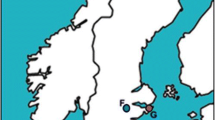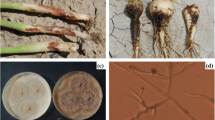Abstract
Genetic variability among 43 isolates of Fusarium oxysporum f.sp. ciceri, the chickpea wilt pathogen, collected from nine states of India including the four well-characterized races of the pathogen were assessed using the molecular markers, RAPDs and AFLP. Principal coordinate analysis of the similarity index data generated from the molecular marker studies mostly gave three different clusters: Of these two clusters represented race-1 and race-2, and the third cluster consisted of race-3 and race-4 pathogen isolates. In RAPDs a fourth cluster was seen which did not go with any of the four races of the pathogen. The molecular markers established the distinctness of race-1 and race-2 pathogen isolates and the close similarity of pathogen isolates of race-3 with that of race-4. AFLP was found to be more informative as it differentiated more number of the pathogen isolates with the known races with minimum of outliers. The high levels of DNA polymorphism observed with the molecular markers suggest the rapid evolution of new recombinants of the pathogen in the chickpea growing fields.
Similar content being viewed by others
References
Singh BK, Dahiye BS. Breeding for wilt resistance in chickpea. Proceedings of the National Symposium on Wilt Problems and Breeding for Wilt Resistance in Bengal Gram, September 1973. Indian Agricultural Research Institute, New Delhi, India (abstract), 1975: 13–14.
Haware MP, Nene YL, Natarajan M. Survival of Fusarium oxysporum f.sp. ciceri in soil in absence of chickpea. In: Management of soil-borne diseases of crop plants. Proceedings of National Seminar, 8–10 January 1986. Tamil Nadu Agricultural University, Coimbatore, India, 1986: 1–2.
Haware MP, Nene YL. Races of Fusarium oxysporum f.sp. ciceri. Plant Disease 1982; 66: 809–810.
Assigbetse KB, Fernandez D, Subois MP, Geiger JP. Differentiation of Fusarium oxysporum f.sp. vasinfectum races on cotton by RAPD analysis. Phytopatholgy 1994; 84: 622–626.
Appel DJ, Fordon TR. Intraspecific variation within populations of Fusarium oxysporum based on RFLP analysis of the intergenic spacer region of the rDNA. Experimental Mycologia 1995; 19: 120–128.
Kim DH, Martyn RD, Magill CW. Restriction fragment length polymorphism groups and physical map of mitochondrial DNA from Fusarium oxysporum f.sp. niveum. Phytopathology 1992; 82: 346–353.
Yao CL, Magill CW, Frederiksen RA, Bonde RR, Wang Y, Wu PS. Detection and identification of Peronosclerospora sacchari in maize by DNA hybridization. Phytopathology 1991; 81: 901–905.
Grajal-Martin MJ, Simon CJ, Muelbauer FJ. Use of random amplified polymorphic DNA (RAPD) to characterize race 2 of Fusarium oxysporum f.sp. pisi. Phytopathology 1993; 83: 612–614.
Rehner SA Uecker FA. Nuclear ribosomal internal transcribed spacer phylogeny and host diversity in the coelomycete Phomopsis. Canadian J Botany 1995; 72: 1666–1674.
Sastry JG, Ramakrishna W, Sivaramakrishnan S, Thakur, RP, Gupta VS, Ranjekar PK. DNA fingerprinting detects genetic variability in the pearl millet downy mildew pathogen (Sclerospora graminicola). Theoret Appl Genet 1995; 91: 856–861.
Geistllinger J, Maqbool S, Kaiser WJ, Kahl G. Detection of microsatellite fingerprint markers and their Mendelian inheritance in Ascochyta rabiei. Mycologia Res 1997; 101: 1113–1121.
Munaut F, Hamaide N, Van der Stappper J, Maraite H. Genetic relationships among isolates of C. gloeossporioides fromStylosanthes spp. in Africa and Australia using RAPDs and rDNA markers. Plant Pathology 1998; 47: 641–648.
O'Neill NR, Van Berkum P, Lin JJ, Kwo J, Ude GN, Kenworthy W, Saunders JA. Application of amplified fragment length olymorphism for genetic characterization of Colletortrichum pathogens of alfalfa. Phytopathology 1997; 87: 745–750.
Restrpo S, Duque M, Tohme J, Verdier V. AFLP fingerprinting: an efficient technique for detecting genetic variation of Xanthamonas axonopodis pv. manihotis. Microbiology 1999; 145: 107–114.
Thyssen A, van Eygen S, Hauben L, Goris J, Swings J, Ollevier F. Application of AFLP for taxonomic and epidemiological studies of Photobacterium damselae subsp. piscicida. Inter J Systemat Evolut Microbiol 2000; 3: 1013–1019.
Janssen P, Coopman R, Huys G, Sings J, Bleeker M, Vos P, Zabeau M, Kersters K. Evaluation of the DNA fingerprinting method AFLP as a new tool in bacterial taxonomy. Microbiology 1996; 142: 1881–1893.
Barve MP, Haware MP, Sainini MN, Ranjekar PK, Gupta VS. Potential of microsatellite to distinguish four races of Fusarium oxysporum f.sp. ciceri prevalent in India. Theoret Appl Genet 2001; 102: 138–147.
Gerlach W, Nirenberg H. The Genus Fusarium — a pictorial atlas. Berlin and Hamburg: Kommisssionsverlang Paul Parey, 1982: 355–358.
Murray M.G, Thompson WF. Rapid isolation of high molecular weight DNA. Nucleic Acids Res 1980; 8: 4321–4325.
Jamil, FF, Sarwar N, Sarwar M, Khan JA, Geistlinger J, Kahl G. Genetic and pathogenic diversity within Ascochyta rabiei (Pass.) Lab. Populations in Pakistan causing blight of chickpea (Cicer arietinum L.). Physiol Molec Plant Pathol 2000; 57: 243-254.
Harris SA. RAPDs in systematics — a useful methodology? In: Hollingsworth, PM, Bateman, RM, Gornall, RJ, eds. Molecular systematics and plant evolution. London: Taylor & Francis Ltd. 1999: 211–228.
Gonzalez M., Rodriguez R, Zavala ME, Jacobo JL, Hernandez F, Acosta J, Martinez J, Simpson J. Characterization of Mexican isolates of Colletotrichum lindemuthianum by using differential cultivars and molecular markers. Phytopathology 1998; 88: 292–299.
Author information
Authors and Affiliations
Rights and permissions
About this article
Cite this article
Sivaramakrishnan, S., Kannan, S. & Singh, S. Genetic variability of Fusarium wilt pathogen isolates of chickpea (Cicer arietinum L.) assessed by molecular markers. Mycopathologia 155, 171–178 (2002). https://doi.org/10.1023/A:1020479512034
Issue Date:
DOI: https://doi.org/10.1023/A:1020479512034




